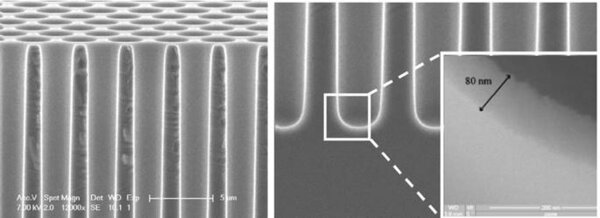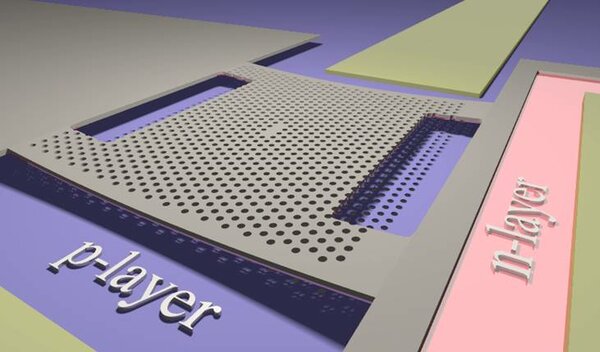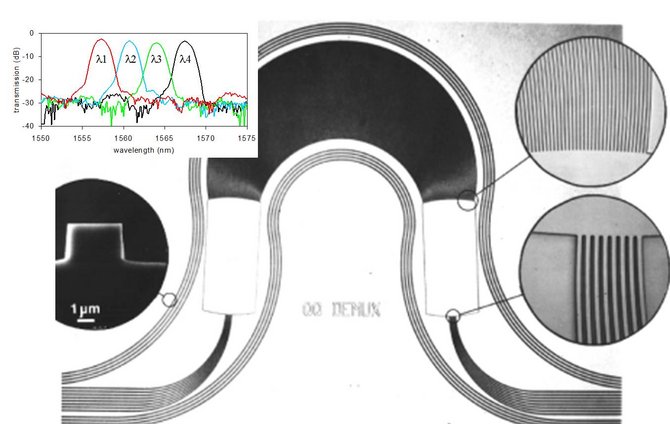From pioneering to international photonics hotspot
Eindhoven has been an internationally recognized stronghold of integrated photonics for over three decades. But how did that come about?
The background story
In the history of integrated photonics in Eindhoven, the Inter-university Research Institute on Communication Technology: Basic Research and Applications, aka COBRA, plays a vital role. This research school was established in the early nineties, and combined Eindhoven University of Technology’s existing strengths in semiconductor materials and telecommunication research with the expertise on optical integration then present in Delft, and the photonic networks activities in Twente.

Launching an era of photonics for communications
‘To me, COBRA was nothing less than launching the era of photonics for communications in the Netherlands – at world-leading level,’ recollects one of the founders emeritus professor Djan Khoe in a recent interview. ‘In all of our research fields, COBRA showed world leading performance from day one,’ he stated with pride.
NRC Photonics: strong base to build upon
Co-founder and emeritus professor Meint Smit has been involved in integrated photonics research for his entire scientific career, and clearly recalls the early days of COBRA. Soon after COBRA was established, the groups of Wolter, Khoe and Smit seized the chance to apply for the so-called ‘Dieptestrategie’: a governmental program aimed at creating national hotspots for specific expertise, he says. ‘Together with the groups of Wolter and Khoe, we wrote a coherent proposal called NRC Photonics that integrated research on materials, components and systems.’ The proposal was awarded with 20 million euros of subsidy from the government for ten years, at that time an unprecedented large sum of money for a research program.

Gravitating toward Eindhoven
‘Since my group – then still in Delft – clearly was the missing link between the materials group of Wolter and the systems group of Khoe, I decided to move to Eindhoven,’ Smit says. Due to some political ado, that took a while. But from 2002 onwards the three groups resided in Eindhoven together. In the meantime Ton Koonen had also transferred from Twente to Eindhoven, effectively concentrating most of the state-of-the-art knowledge about electro-optical communication at Eindhoven University of Technology.
Focusing on indium phosphide
Early on, the Eindhoven researchers decided to focus on so-called III-V semiconductors. That was an important decision, Smit says. ‘In silicon photonics, which came up at that time, there are many large players and there is a lot of competition, while in indium phosphide, there was more to gain for us.’ The main advantage of InP is that it is possible to integrate the full circuit in a single chip, including lasers and optical amplifiers. This lowers the assembly costs with respect to silicon, where you always have to assemble the lasers in a hybrid way.
State-of-the-art cleanroom
An important asset of the Eindhoven integrated photonics research is the 800m2 cleanroom that opened in 2002 as TU/e’s contribution to the NRC Photonics program. Over the years, this cleanroom has turned out to be of great importance for the research, since it enabled in house characterization and production of new materials and devices. To ensure that photonic technology would not be restricted to an academic environment, later on the cleanroom became part of the national NanoLabNL infrastructure, which enables external users to characterize photonic materials, components and devices with the aid of the Eindhoven equipment and expertise.

International excellence
In 2010, an international committee of international reviewers from industry and academia stated that ‘The COBRA NRC of photonics is only rivalled by industrial laboratories and by one or two US initiatives. COBRA’s research is an essential pillar of the European dominance in photonic integration. Both the excellent infrastructure and the competences of COBRA have made TU Eindhoven a center of international standing. Researchers come from throughout Europe and worldwide to Eindhoven to interact or collaborate.’
Successful grant applications
‘Over the years, we managed to obtain many large national and European grants, and we almost tripled the total budget of 35 million euros initially invested in the NRC Photonics program,’ Smit illustrates the quality of the research done in Eindhoven over the past thirty years. Many of those grants were awarded to individual researchers based on their qualities, in prestigious schemes like the Dutch ‘Vernieuwingsimpuls’, or ERC Advanced Grants. The biggest joint program was awarded in 2014, by the time the NRC Photonics program ended. This Gravitation Program ‘Research Centre for Integrated Nanophotonics’ was awarded with 20 million euros for ten years.
Adding extra expertise
To strengthen the hardware/technology development side, in the Gravitation program two extra physics groups were added to the three original COBRA-members, leading to the establishment of the new Institute for Photonic Integration. ‘The Institute for Photonic Integration is the result of decades of structural governmental funding, that started with the Governmental stimulation plan on Micro-electronics and culminated in the Gravitation Program. Now it is time to harvest from these investments. The technology is market-ready, and with the establishment of PhotonDelta and the PITC we are going to develop it further to make it commercially viable,’ Smit concludes.

Integrated photonics at TU/e
Timeline
1986 Governmental stimulation plan on Micro-electronics, supporting existing excellent opto-electronic groups in Delft, Eindhoven and Twente.
1994 Djan Khoe (Telecommunications, TU/e), Ton Koonen (Photonic Networks, UT), Meint Smit (Components, TUD) and Joachim Wolter (Semiconductor Physics, TU/e) establish COBRA, the Inter-University Research School on Communication Technologies Basic Research and Applications.
1996 KNAW recognizes COBRA as a leading research school.
1998 COBRA is appointed top research school by the Dutch government, and receives an NRC Photonics grant of about 20 million euros for ten years. On top of that, TU/e commits to investing in the development of a state-of-the-art cleanroom.
2000 Meint Smit transfers with his group from TUD to TU/e.
2001 Ton Koonen is appointed full time professor at TU/e.
2002 The COBRA cleanroom is ready for use.
2006 NRC Photonics gets funding for an additional 5 years.

2007 TU/e takes the lead in organizing multi project wafer runs, to enable researchers and small companies to share the costs of producing innovative photonic chips.
2010 Spin-off company EFFECT Photonics founded, supplier of highly integrated optical communications products.
2010 The COBRA cleanroom becomes part of national research infrastructure NanoLabNL, opening its doors for external users.
2012 Establishment spin-off company SMART Photonics, the world's first pure-play foundry for Indium Phosphide photonics semiconductors.
2014 The physics groups of Erwin Kessels and Bert Koopmans join the research team. Gravitation program Research Centre for Integrated Nanophotonics awarded with 20 million euros.
2016 The Institute for Photonic Integration is established to succeed COBRA.
2016 TU/e, together with Brainport Development, The Brabant Development Agency, Effect Photonics, Mesa+, LioniX International, Smart Photonics, Phoenix Software and Genexis, take the initiative to form PhotonDelta, an innovation hub that links best-in-class research and development to best business practice.
2018 PhotonDelta establishes the Photonic Integration Technology Center, an independent European-based organization that can help scale up photonic technology to enable volume manufacturing.
Research milestones
- The Arrayed Waveguide Grating (AWG) was invented by COBRA and is now a commonly used key building block in any optical wavelength division, multiplexed communication system. Anybody using the internet also uses AWGs.
- COBRA has introduced MMI-couplers to semiconductor-based integration technology. MMI-couplers are presently the most frequently used couplers in photonic integrated circuits.
- COBRA researchers develop a technology in which the most commonly used building blocks for photonic integration can be integrated in a highly standardized (generic) process, and they launch the world’s first Multi-Project Wafer runs in an InP-based platform.
- COBRA researchers were the first to demonstrate electrically pumped lasing operation in metallic cavities with dimensions well below the diffraction limit. Following this first publication on plasmonic lasers, many research groups worldwide are now working on this topic.
- In collaboration with Nokia Siemens networks, COBRA researchers pioneered DQPSK optical transmission. Many of the results found application in real world systems.
- COBRA carried out the first system experiments on optical packet switched systems that are controlled by optical signals. Several photonic memory ICs were realized within COBRA; some of them have led to prototype commercial devices, which are now used by many research groups.
- COBRA was the first to introduce dynamic optical routing techniques for fiber access networks (US patents granted). Concepts related to wavelength-routed access networks have been taken beyond laboratory setups, and proven in various field trials by industrial partners.
- Radio-over-fiber techniques with extreme dispersion-robustness, making them suitable for in-building multimode fiber networks, were first introduced by COBRA (patent granted).
- Many essential aspects of semiconductor nanowire growth, such as a control over stacking faults and crystal structure, have been discovered by one of our team members.
- InAs/InP quantum dot formation for operation at 1.55 micron, and the creation of photonic devices such as lasers that are based on InAs/InP quantum dots, were pioneered at COBRA.
- It was a team led by COBRA members who demonstrated the first telecom-wavelength, high-speed photon-number-resolving detector.
- TU/e researchers have pioneered the development of plasma-assisted atomic layer deposition (ALD) processes as well as the application and scale-up of ultrathin ALD films for the surface passivation of semiconductors for photonic and photovoltaic devices.
- COBRA researchers reported the creation of a novel tunable laser that may play an important role in future packet-switched optical networks. The laser is based on a novel tuning principle that allows for tuning speeds of 1 ns, 100 times faster than today's commercially available integrated tunable lasers.
- Another successful example is the best performing mode-locked ring laser to date, operating in the long wavelength telecommunication window, which has been developed at COBRA. This included the development of compact polarization converters.
- In addition, COBRA found new ways of using splitters as generic building blocks in polarization-handling circuits.
- COBRA’s design for a dynamically reconfigurable optical-access network linked to the home has been tested successfully in the field.
- COBRA-researchers packaged the world’s smallest WDM cross-connect, and produced the world’s smallest optical flip-flop. They have also obtained some world records in switching optical data packets of sub-Tb/s using only one semiconductor optical amplifier.